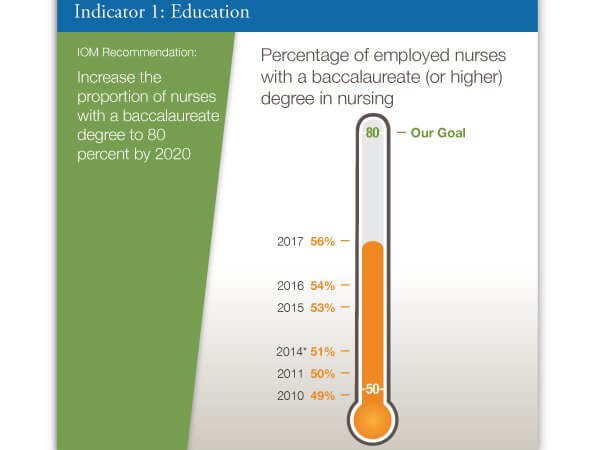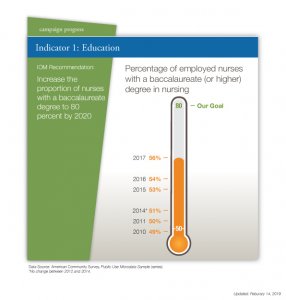
Feb 20, 2019
We’re Making Headway on the IOM Nursing Goals

For nearly a decade now, the Future of Nursing: Campaign for Action, our state-based Action Coalitions, and supporters and allies across the nation have worked tirelessly to implement the Institute of Medicine’s Future of Nursing report recommendations. To help mark our progress, the Campaign established a series of more than two dozen national measures we call the Dashboard. Twice yearly, we update these measures to see how far we have come, and where we need to make progress.
Our latest update shows that headway continues toward meeting the IOM’s nursing goals, with noteworthy progress seen in some of the education and diversity measures. Here are the highlights:
- The percentage of employed nurses with a bachelor’s degree or higher in nursing in the US is at an all-time high of 56 percent in 2017, up from 49 percent in 2010.
- The number of employed nurses with a doctoral degree in the US grew to an all-time high of 28,004 in 2017—a figure that has more than tripled since 2009.
- More than 5,600 nurses now officially report serving on boards, meaning the Nurses on Boards Coalition is more than halfway to its goal of getting 10,000 nurses on boards by 2020.
- The number and proportion of new RN graduates who are male is increasing.
- Pre-licensure RN program graduates were 14.1 percent male in 2017, up from 12.2 percent in 2010.
- From 2010 to 2017, the number of male RN graduates increased 29 percent (from 16,386 to 21,134).
- The number and proportion of new RN program graduates from racial/ethnic minorities is increasing.
- From 2010 to 2017, the number of minority RN graduates increased by 43 percent (from 31,571 to 45,290).
- In 2017, minority nursing students made up about 30.2 percent of all graduates, up from 23.6 percent in 2010.
- The number of RNs from racial/ethnic minorities is growing. From 2016 to 2017, the number of RNs who identify as American Indian or Alaska Native, Hispanic or Latino, Asian, Black or African American, two or more races, or another race all increased.
Action Coalitions and other stakeholders may also find useful our updated series of state-specific diversity data, which are part of the Dashboard. These charts compare the racial and ethnic composition of each state with the racial and ethnic composition of that state’s RN pre-licensure nursing graduates in 2017, providing an easy snapshot of how well a state’s nursing student population reflects the diversity of that state.
For more information, view the primary Dashboard indicators (which cover progress in seven areas identified in the IOM report) and the secondary Dashboard indicators (which provide further support measures for each primary Dashboard goal). Working together, we are paving the way toward the stronger, better-prepared, and more diverse nursing workforce that our nation needs.
